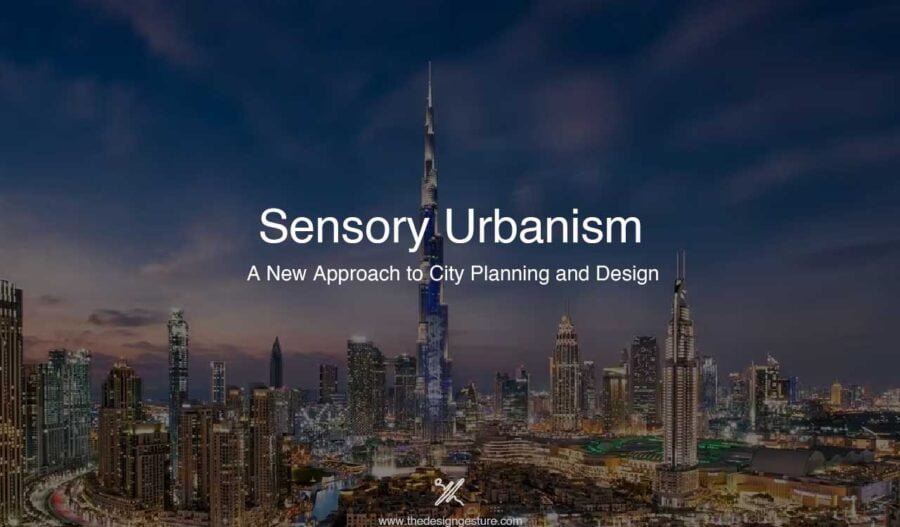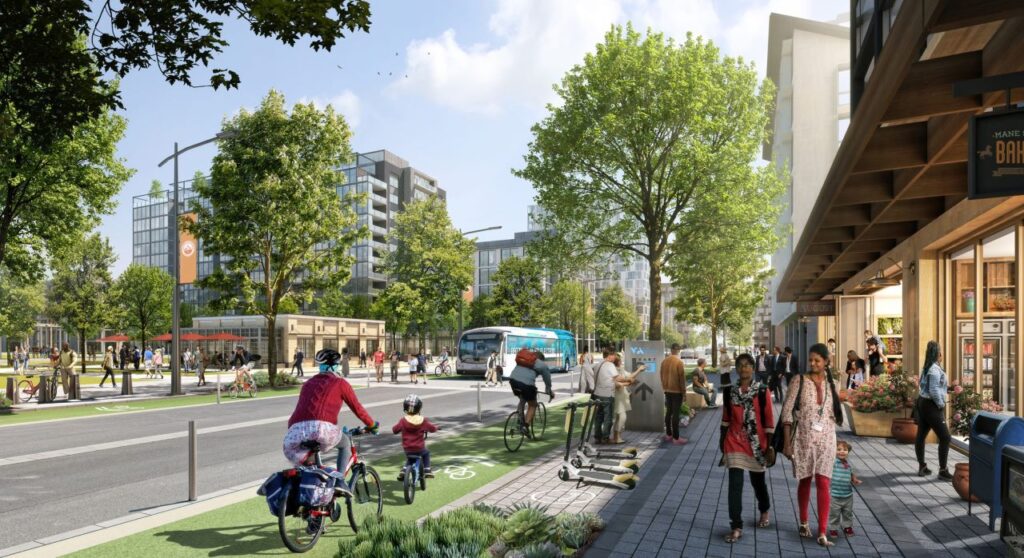Table of Contents
Introduction
The mental image that most cities evoke today is that of the ‘skyline’ of the cities which in itself reveals the visual dominance in perceiving the city. Sensory design is a theory that emerged to combat this dominance. While a city’s skyline projects itself as a well-developed global city with modern technologies and exponential economic growth, it tends to ignore the people that inhabit this global city. The experience of people in such global cities may be limited to visual perception and the people remain unattached to the city. Sensory Urbanism intends to tackle the above issue.
Perception, Imageability, and Sensorial Experience in Urban Environments
While it is true that components like paths, edges, districts, nodes, and landmarks make up the urban environment physically, it is the interaction of the people with this environment that constitutes a place. It is ironic to ignore the inhabitants who tend to be the purpose of urban developments, solely focussing on the built. However, theorists like Kevin Andrew Lynch appropriately project urban environments as perceptual outputs of the people.
Environmental perception is an inevitable dimension of Urban Design. Perception at its core is about the user’s ability to gather, organize, and translate the information about the environment he/she occupies. In this context, there is an ever-happening interaction between the user and the environment that the user inhabits. The user perceives the space or senses the space with his/her visual, aural, tactile, and olfactory capabilities. A heightened sensorial experience in cities may lead to a sense of place depending on the user’s experience with similar settings.
Lynch was way ahead of his time, discussing in what ways urban planners can design the urban environment depending on how people perceive the nuances of the cities, in his book “The Image of the City” and his other publications. In “The Image of the City”, he coined the term imageability, indicating the ability of a physical object in the urban environment to evoke the mental image of the city, to contribute to the complete sensorial perception of the city.
He argues that the mental image of the same city may vary from person to person as it is influenced by both the sensorial perception of the objects in the environment and users’ memory or relation with that particular object. However, he believes that by understanding merely the imageability of the urban object (and not necessarily exploring the individual relation or memory with urban objects), urban planners can effectively design or rebuild the ever-evolving cities as places with high imageability or legibility.
A city with high imageability. How are they better than conventional cities? Lynch quotes Venice as a highly imageable city. Water canals and Bridges. Spotted in films and series. Constitutes buildings that belong to various historical architectural styles. Byzantine, Gothic, Ottoman, and The Venetian Gothic! Venice is a city with a rather rich architectural character elevating the experience. According to Lynch, a highly imageable (legible or visible or apparent) city provides a rich sensory experience that can be intensified over time.
To be precise, Lynch expects the city’s basic image to be anchored to a strong salient urban object which is prevalent throughout the city forever, like the water canals of Venice, and believes that the other changes taking place in the urban environment would only add to the sensorial experience without altering the basic image of the city.
The sensory experience in highly imageable cities contributes to the increased awareness of the user in space, easy wayfinding, and clear orientation of the user in space. And Sensory Urbanism is all about this enriched “sensorial experience” in urban environments.
Sensory Urbanism
Sensory urbanism is an interdisciplinary field that emphasizes the importance of incorporating heightened sensory experience in cities in order to develop cities as appealing, human-centric, and inclusive. On a deeper level, planners try to enrich the sensorial experience in cities by creating cities appealing to even the lesser-known senses like proprioception and thermoception, in addition to the five accepted senses of sight, sound, touch, taste, and smell. The ultimate aim is to design urban spaces such that the overall experience and livability of the inhabitants are enhanced.
Inducing Sensorial Experiences to the Urban Centers
Approaching Sensory Urbanism as a means to understand how information gained by sensorial perception defines a city’s character and affects the inhabitants’ encounter with the cities, researchers are working with various traditional methods and digital technological inputs to identify ways to incorporate all the senses in experiencing the city positively.
Oğuz Öner, a researcher of sensory urbanism from Turkey has used sound walks to identify aural issues and potential in Istanbul. He has organized several such walks where blindfolded participants traverse the streets of Istanbul and describe what they hear at certain distinct points. He relies on the information collected to propose solutions like installing a wave organ to amplify the sound of the sea or planting vegetation to absorb undesirable traffic noises.
This method is based on a participatory approach and individual feedback from various people and is also adopted by the City of Berlin. Citizens of Berlin use a free mobile app to identify quiet and calm spaces and the officials protect these spaces from any sort of increased noise as a part of the city’s noise action plan and EU Legislation.
While the above cases deal with the aural perception of the city, the City of Singapore also explores the tactile experience of the city intending to create inclusive cities, making navigation easier for differently abled people. This is achieved with the help of tactile pavements, audio guidance, and other sensory cues. This effort unveils the innate advantage of sensory urbanism, which is inclusive design.
The EU-funded GoGreenRoutes project is using nature-based solutions to respond to information gained by both participatory approaches and digital innovation, to create Burgas in Bulgaria, Lahti in Finland, Limerick in Ireland, Tallinn in Estonia, Umeå in Sweden and Versailles in France as “Urban Well-being Labs”. They are bringing in two new aspects to the discussion of sensory urbanism; nature as a sensory experience inducer and well-being or improved (physical and mental) health as the outcome. They are creating green corridors, linear parks, pocket parks, and shared walkways in these six cities to increase the public space, create a natural soundscape, provide better thermoception, and enhance the physical and mental health of their urban residents.
The Conundrum
Recollecting the so far undiscussed element of user’s memory’s influence on their sensorial experience and understanding the city as a host satisfying the needs of thousands of people not just one person, is where the challenge of designing sensorial experience in cities begins. It is quite challenging to decide which sensory experience to incorporate in cities, especially when urban inclusion and equity are to be met. Though Lynch leaves behind this element of personal preferences, Monica Montserrat Degen, an urban cultural sociologist at Brunel University London specifically works on it. She believes that these preferences are socially and culturally shaped.
Clarifying her take on sensory hierarchies in urbanism, she explains with an example of a neighborhood in London. Cheaper restaurants were replaced with trendy cafes to please the new residents who found the place to smell full of fried chicken, unappealing not welcoming. However, now she finds that place to smell like cappuccinos. The youngsters may prefer the smell of fried chicken while the new residents did that of cappuccinos. Their memories associated with the place are different and hence their ideal sensorial experience varies.
Urban socio-cultural and economic diversities may be quite a challenge for planners to tackle while implementing sensorial experience solutions in the city. However, as Lynch and GoGreenRoutes suggest nature might be a better place to seek solutions. On examining the issues that arise over ideal sensorial experience, sensorial experience aroused by natural elements, like green corridors, water canals, sea, and grass are a better option to consider because of the innate human character to connect with nature despite the socio-cultural differences. The Sentosa Sensoryscape, a half-kilometer sensory walk project in Singapore is a complete feast for all the senses designed, realizing the imageability of natural elements like scented vegetation, flowing water, edible plants, etc paired with digital technologies.
FAQ
- What is wave organ?
The Wave Organ is a wave-activated acoustic sculpture conceptualized by Peter Richards and sculpted by George Gonzalez. It is located on a jetty in the San Francisco Bay.
- What is proprioception?
Awareness of one’s body in space.
- What is thermoception?
Awareness of temperature or the ability to sense temperature




